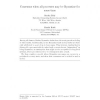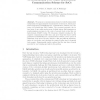SSS
2009
Springer
14 years 6 months ago
2009
Springer
Self-stabilization is an elegant way of realizing non-masking fault-tolerant systems. Sustained research over last decades has produced multiple self-stabilizing algorithms for man...
SSS
2009
Springer
14 years 6 months ago
2009
Springer
SSS
2009
Springer
14 years 6 months ago
2009
Springer
SSS
2009
Springer
14 years 6 months ago
2009
Springer
Abstract. The problem of self-optimization and adaptation in the context of customizable systems is becoming increasingly important with the emergence of complex software systems a...
SSS
2009
Springer
14 years 6 months ago
2009
Springer
A snap-stabilizing protocol, starting from any configuration, always behaves according to its specification. In this paper, we are interested in message forwarding problem in a m...
SSS
2009
Springer
14 years 6 months ago
2009
Springer
We present a simple algorithm that implements the Omega failure detector in the crash-recovery model. The algorithm is quiescent, i.e., eventually all the processes but the leader ...
SSS
2009
Springer
14 years 6 months ago
2009
Springer
Consider a fully connected network where up to t processes may crash, and all processes start in an arbitrary memory state. The self-stabilizing firing squad problem consists of e...
SSS
2009
Springer
14 years 6 months ago
2009
Springer
We propose a communication scheme for GALS systems with independent but approximately synchronized clock sources, which guarantees high-speed metastability-free communication betwe...
SSS
2009
Springer
14 years 6 months ago
2009
Springer
Efficiency of optimistic fair exchange using trusted devices is studied. Pfitzmann, Schunter and Waidner (PODC 1998) have shown that four messages in the main sub-protocol is op...
SSS
2009
Springer
14 years 8 months ago
2009
Springer



